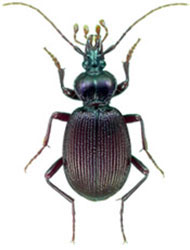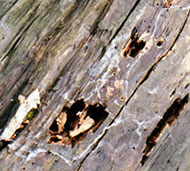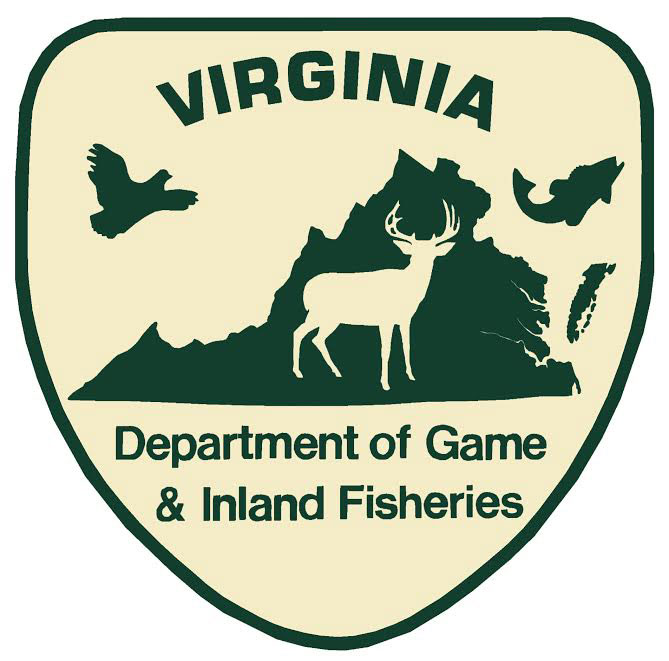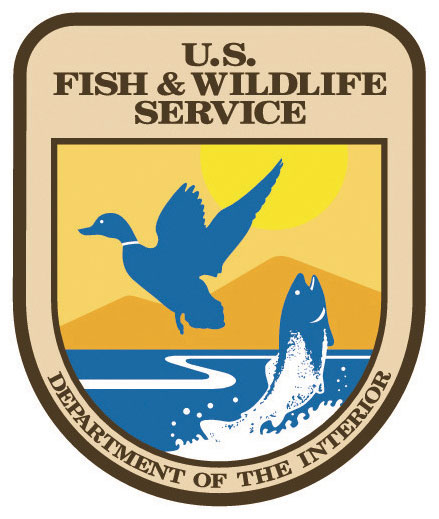Land Snail Ecology
 Scaphinotus bilobus (Cychrini); Canadian Biodiversity Info Facility
Scaphinotus bilobus (Cychrini); Canadian Biodiversity Info Facility

Slug slime trail at log refuge; Ken Hotopp
©

A firefly larvae attacks an immature polygyrid snail, Ken Hotopp ©.
Predators & Defenses
A variety of predators eats land snails and slugs, as they are small and slow-moving invertebrates. Abundant and nutritious prey, land snails might be considered "low" on the food chain. In response to this predation, land snails have evolved an array of sophisticated defenses.
Invertebrate predators of land snails include beetles and their larvae, millipedes, flies, mites, nematodes, and other snails. Vertebrate predators of snails and slugs include shrews, mice, squirrels, and other small mammals; salamanders, toads and turtles, including the uncommon Blandings Turtle Emydoidea blandingii; and birds, especially ground-foragers such as thrushes, grouse, blackbirds, and wild turkey. By far the most comprehensive account of these land snail predators is found in Natural Enemies of Terrestrial Molluscs, edited by G.M. Barker (2004).
Land snail defenses against predators include cryptic coloration and texture; thickened shells and aperture barriers; defense mucus production including irritating smells and tastes; hiding behaviors, and rapid withdrawal or dislodging movements.
How predators eat land snails differs according to their size and capabilities. For shelled land snails, beetle larvae may enter the aperture of a snail's shell, while larger beetles can crush small snails. Predatory snails can rasp a hole in a victim's shell, then insert their head to feed. Small mammals will break a hole in the shell to pull out the snail's body, sometimes leaving the empty shell on a rock or log. Larger predators such as wild turkey can swallow even big snails whole.
While most land snails are herbivores or detritivores, some are specialized predators themselves. The Gray-foot Lancetooth Haplotrema concavum is a large predatory land snail that attacks nematodes and other snails, and is a widespread native in Pennsylvania. This predator will insert its head into the aperture of a prey snail's shell, or can drill a hole in the shell to gain access. Pearce and Gaertner (1996) were able to predict which snail prey were most preferred by the lancetooth using information about how well-armed those prey were. The Oval Ambersnail Succinea ovalis has a large aperture and thin shell, and was attacked most often, but the small Maze Pinecone Strobilops labyrinthica with its thick shell and narrow aperture, was least preferred.
Another predator and prey relationship of note is an apparent "arms race" between land snails and Cychrine beetles (Carabidae), which feed mostly on land snails (Symondson, 2004) - while the beetles have evolved narrower heads to extract snails from their shell aperture, the snails have evolved more obstructed apertures (which would also help in defense against the lancetooth).
Cychrine beetles have an elongated head, thorax, and mouthparts that help them gain entry through the aperture of snail shells, while less-specialized beetles may simply crush snail shells when possible (e.g., Digweed, 1993). Mouthparts of the Cychrini have been described as having "hooks" or "spoons" that help extract mollusk flesh. Some snails in turn, have barriers of shell calcium, called denticles or lamellae, which partially obstruct their aperture (e.g. Solem, 1972). The plasticity of the land snail head and foot allow their protrusion through the aperture despite the obstacles. However, these "teeth" obviously thwart the entry of beetles and other small predators having hard exoskeletons. Some snails in the slitmouth genus (Stenotrema: Polygyridae) are so well armed - with a hard round shell, covered by hair-like processes, and a slit-shaped aperture blocked by lamellae - as to appear impervious to attack.
Further research is needed to demonstrate whether barrier adaptations have evolved specifically for defense purposes. Other hypothesized functions for barriers include storing calcium for other physiological needs, trapping air if the animal becomes immersed in water (Emberton, 1995); or providing leverage "handles" on the shell so it can be moved and balanced by the animal (Suvorov 1993, 1999).
Other land snail defenses include cryptic coloration, which hides them from predators that search by sight. Few land snails in North America are brightly colored, most are brown or tan, and many have finely-textured shells that do not reflect light. For example, the tiny pinecone snails (genus Strobilops) are almost indistinguishable from the fruiting bodies of fungi on rotten logs. Some species such as the velvet wedge Xolotrema denotata have hairlike processes on their periostracum that hold onto dust and spider webs, making an effective camouflage.
Another typical land snail defense mechanism is the production of mucus. Although mucus normally aids in maintaining a snail's skin and promoting locomotion, a defensive version is exuded in large amounts when a snail is attacked. The smothering or confusing effect of the sticky secretions can help to stop predators (e.g., Eisner and Wilson, 1970; Parkarinen, 1994). Many slugs have even more copious and stickier defense mucus, suggesting an anti-predator function compensating for the lack of a shell.
Defense mucus likely contains chemicals repellent to predators, but this is not well studied in terrestrial gastropods (this phenomenon has been established for marine snails). Domestic dogs and cats avoid slugs, and a pet lizard fed the introduced European slug Arion subfuscus was rendered comatose for several days. Some color forms of A. subfuscus are quite orange, suggesting that they may be advertising their toxicity to would-be predators. Defense mucus of several snails is visible under ultraviolet light, suggesting their toxicity is being advertised to insect predators that see in that portion of the light spectrum (D. Dourson, pers comm). Some snails and slugs are attacked by ants, while others are ignored, so there may be ant-specific defense chemicals that have evolved only in some snails (Hotopp, pers obs).
For defense against much smaller attackers, land snail mucus is known for its antibacterial properties, with some constituents used to treat acne.
During periods of inactivity land snails appear to hide from potential predators. Land snails that live among rock talus or cliffs tend to remain immobile on ceilings, vertical surfaces and within cracks, rather than in locations that might be more accessible to small mammals. In the Northeast during summer months, the land snail Neohelix albolabris is typically found singly upon woody debris and snags above ground level. For aestivation, some larger land snails move from leaf litter to sticks, logs or rocks, though in addition to predator avoidance, this behavior may also aid in retaining moisture, avoid pooling water, or other functions.
Many shelled land snails will rapidly withdraw into their shell when attacked, or sometimes when merely sensing wind or movement. For example, the land snail Webbhelix multilineata frequently drops from low vegetation when disturbed. Large Neohelix sp. land snails kept in a terrarium will sometimes be seen rapidly twisting their shell when another snail is crawling upon it. This behavior appears to be an attempt to dislodge the attached snail.
Finally, if a land snail does survive a predator's attack, it has impressive powers of regeneration. Damage to shells can be repaired by the snail's shell-building mantle, although it often appears that repairs are most complete when the break is in the final "body" whorl of the shell. Field collectors are familiar with this phenomenon, as recovered shells often show irregularities where "patches" have been made. Land snails are also able to regenerate some tissue that has been lost, including parts of the foot and tentacles (e.g., Bobkova, et al., 2004).
Ken Hotopp and Tim Pearce 2/2014



Development of this site was supported by the generous contributions of Pennsylvanians to the Wild Resource Conservation Fund, and by the Virginia Dept. of Game and Inland Fisheries with a State Wildlife Grant from the US Fish & Wildlife Service.
